Turn HubSpot into an ROI Engine with Multi-Touch Attribution
Discover how Attribution’s HubSpot integration gives B2B teams audit-ready ROI — connecting spend, CRM data, and revenue in one system of truth.
written by: Ryan Koonce

Discover how Attribution’s HubSpot integration gives B2B teams audit-ready ROI — connecting spend, CRM data, and revenue in one system of truth.
written by: Ryan Koonce

In today’s B2B environment, growth no longer follows a straight line. The path from awareness to revenue is multi-threaded — often involving a dozen stakeholders, multiple channels, and months of engagement before a deal ever closes. Yet most reporting systems still reduce that complexity to a single data point: the last click. That’s like judging a football game by its final play. Multi-touch attribution (MTA) exists to fix that gap. It connects every ad impression, email, demo, and conversation back to revenue — showing how the entire customer journey contributes to outcomes, not just the final conversion.
And today we'll look at the app that can help you achieve one of the most effective MTA systems: Attribution.app.
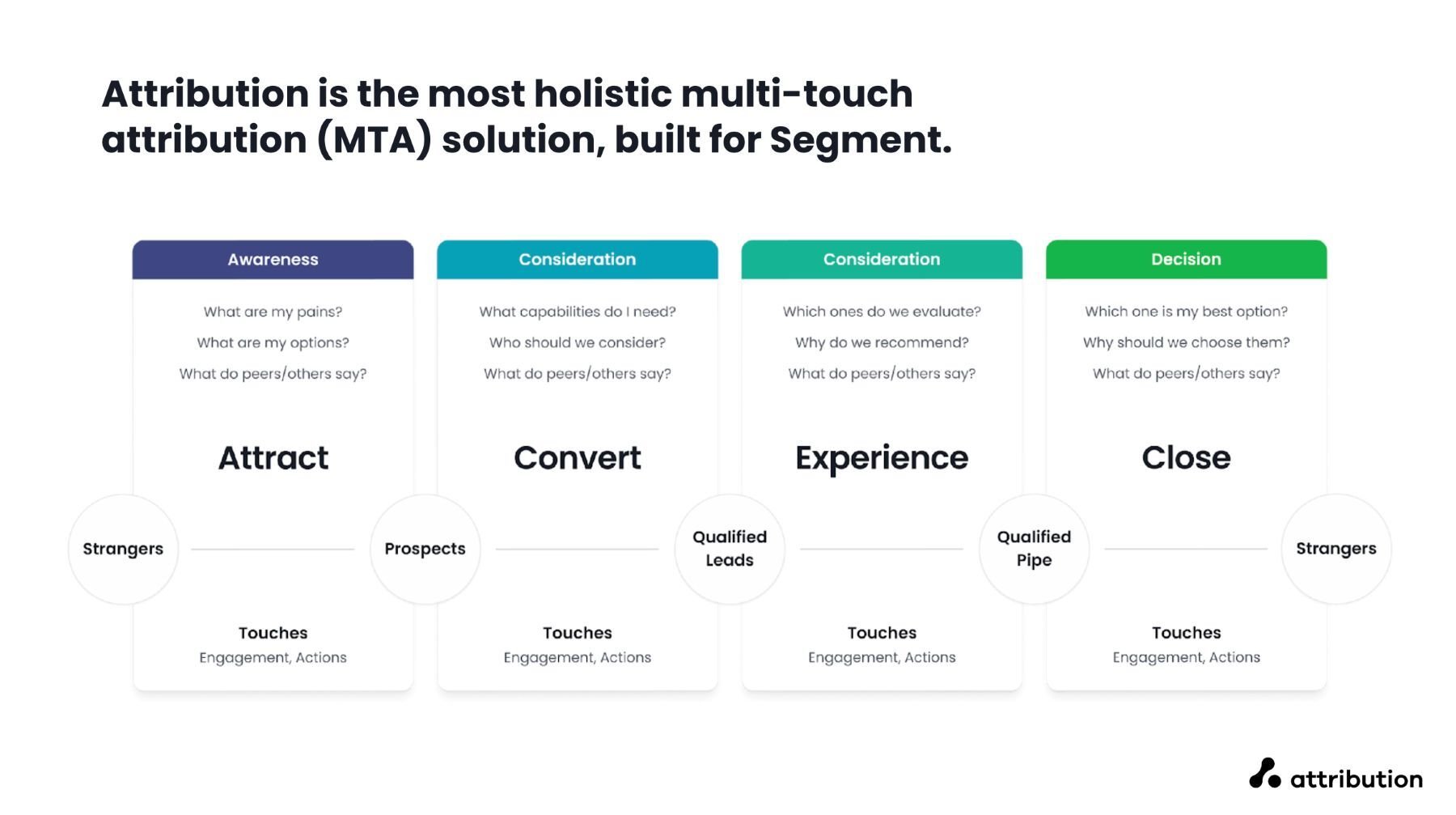
The B2B Attribution (How It Works) framework (see image above) captures this visually. It maps the modern buyer journey across four key phases — Attract, Convert, Experience, and Close — showing how teams move from strangers to qualified pipeline.
Each stage involves its own signals: awareness campaigns that introduce the problem, nurture touches that build trust, and sales engagements that ultimately convert. Attribution measures all of it. By tracing engagement and spend across every phase inside HubSpot, founders and RevOps leaders can see not only what happened but why it worked. This full-funnel visibility transforms data from historical reporting into a real-time decision layer.
What makes MTA so valuable is its precision. Instead of guessing which campaigns “probably” influenced a deal, startups can track every touchpoint that did — weighted accurately by its impact on the sale. This allows GTM teams to allocate spend surgically, measure CAC Payback and LTV:CAC with investor-grade accuracy, and spot inefficiencies before they scale. In the process, HubSpot shifts from being a CRM of record to a financial engine for growth efficiency. As I like to say: “HubSpot turns leads into customers; Attribution turns HubSpot into an ROI engine.”
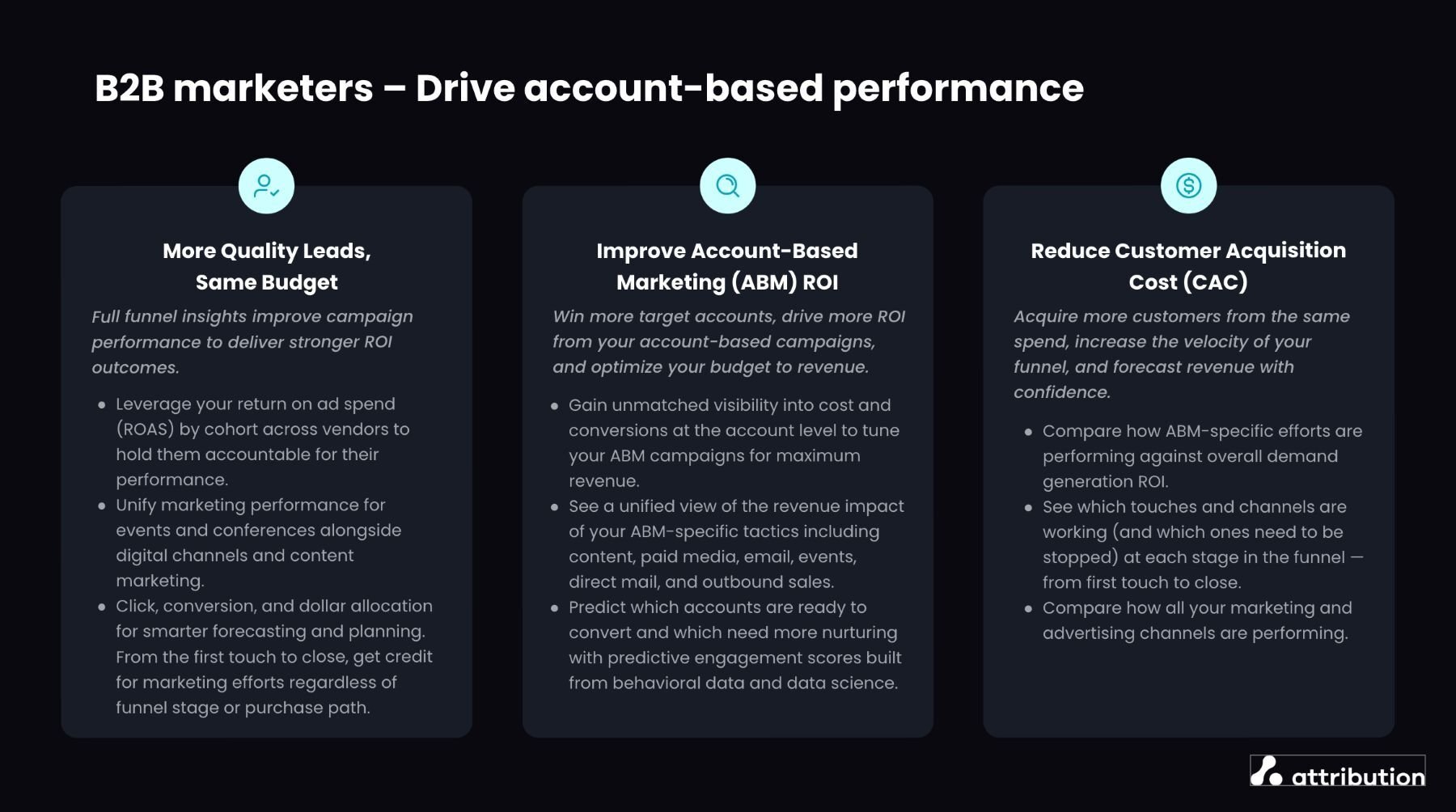
The Account-Based Performance model (pictured above) brings this to life. It shows how MTA empowers B2B marketers to drive higher ROI across three key outcomes: more quality leads on the same budget, better ABM performance, and reduced customer acquisition cost (CAC). When every touchpoint is connected — ads, events, emails, content, outbound — teams gain the ability to compare which efforts truly move accounts forward, and which ones don’t. That means no more channel silos, no more double-counted conversions, and no more CFO debates about where the budget actually went.
Ultimately, MTA is about truth — not just tracking. It’s about building a unified understanding of what drives growth across marketing, sales, and finance. By integrating directly with HubSpot, Attribution turns the marketing funnel into a measurable financial system — one where teams can forecast with confidence, prove ROI on every dollar, and grow smarter, not just faster. For startups scaling on HubSpot, this is the maturity shift that separates activity from efficiency — and visibility from profitability.
Multi-touch attribution turns HubSpot into a financial system of truth—connecting every campaign, ad, and touchpoint to actual revenue so teams can see not just what happened, but why it worked. It replaces guesswork with measurable ROI, enabling startups to grow smarter, not just faster.
Most marketers today think they’re doing attribution — but they’re not. They’re doing fragments of it. Most systems only tell part of the story: what happened after a lead fills out a form or what channels appeared to drive conversions. That’s because the majority of attribution models used in CRMs or ad platforms operate on partial data — often limited to first-touch, last-touch, or U-shaped models that ignore the majority of a buyer’s journey. In B2B, where a single deal can span months and dozens of touches, across many stakeholders, this gap isn’t just inconvenient — it’s costly.
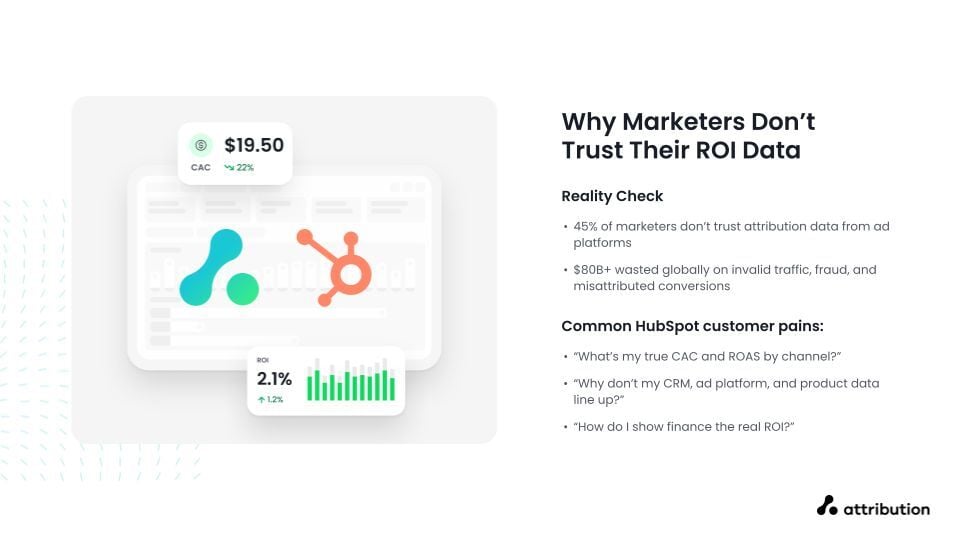
The “Why Marketers Don’t Trust Their ROI Data” visual shows just how deep the problem runs: 45% of marketers don’t trust their attribution data, and over $80 billion is wasted annually on invalid or misattributed conversions. HubSpot customers feel this acutely — CRM data says one thing, ad platforms say another, and product analytics adds a third story entirely. The result? CMOs can’t confidently answer basic questions like, “What’s our true CAC?” or “Which channels actually generate revenue?” Without connecting spend and outcomes, attribution turns into a guessing game disguised as reporting.
Even when tools promise “multi-touch attribution,” they often stop short of full transparency. Native HubSpot models, for example, are powerful for post-lead engagement but don’t include the pre-lead journey — the anonymous ad clicks, social touches, and offline events that actually create demand. This is where Attribution fills the gap – by integrating cost, CRM, and identity data at every stage, it delivers true multi-touch attribution — one that begins before the form-fill and continues through to revenue. It’s the difference between tracking activity and auditing ROI.
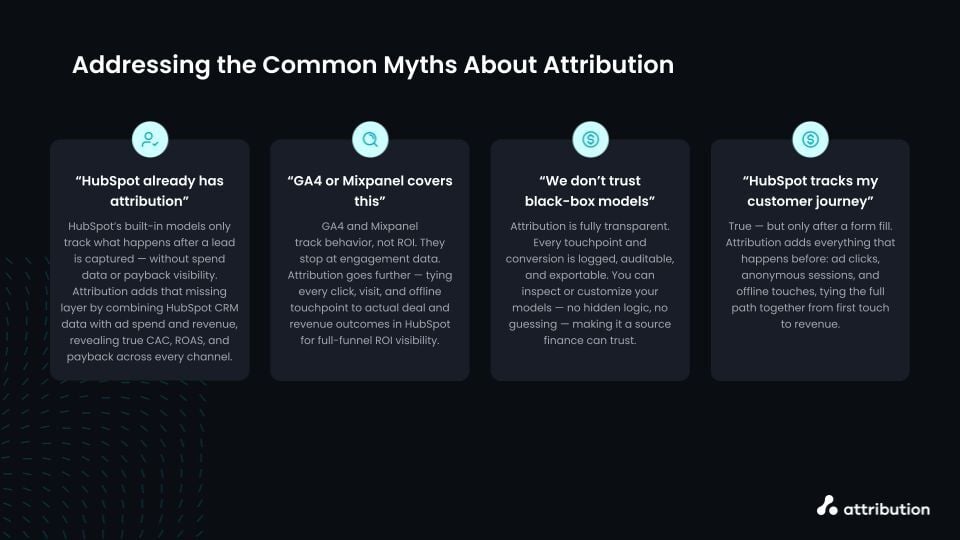
Another major issue with legacy MTA solutions is their lack of auditability. Most are black boxes — teams can’t inspect, export, or customize the models. The “Common Myths About Attribution” graphic visualizes this tension: marketers don’t trust black-box models, finance doesn’t trust marketing’s math, and everyone is left reconciling spreadsheets. Attribution’s approach — exporting user-level logs directly to warehouses like Snowflake or BigQuery — flips this narrative. Every click, cost, and conversion is visible, verifiable, and defensible in front of a CFO.
Ultimately, today’s broken attribution landscape isn’t a failure of technology — it’s a failure of integration. True multi-touch attribution requires unifying HubSpot’s CRM signals with marketing spend, product usage, and revenue data. Without that connection, you’re left with disconnected dashboards instead of a single source of truth. HubSpot captures the who and when of engagement. Attribution binds it all together, and brings the how much and why it matters. Together, they give startups what they’ve been missing for years: true ROI for HubSpot.
Most attribution tools only show fragments of the buyer journey, leaving HubSpot teams with disconnected data and guesswork instead of clarity. Attribution fixes that by unifying cost, CRM, and revenue data into one auditable system—turning fragmented reporting into true, end-to-end ROI inside HubSpot.
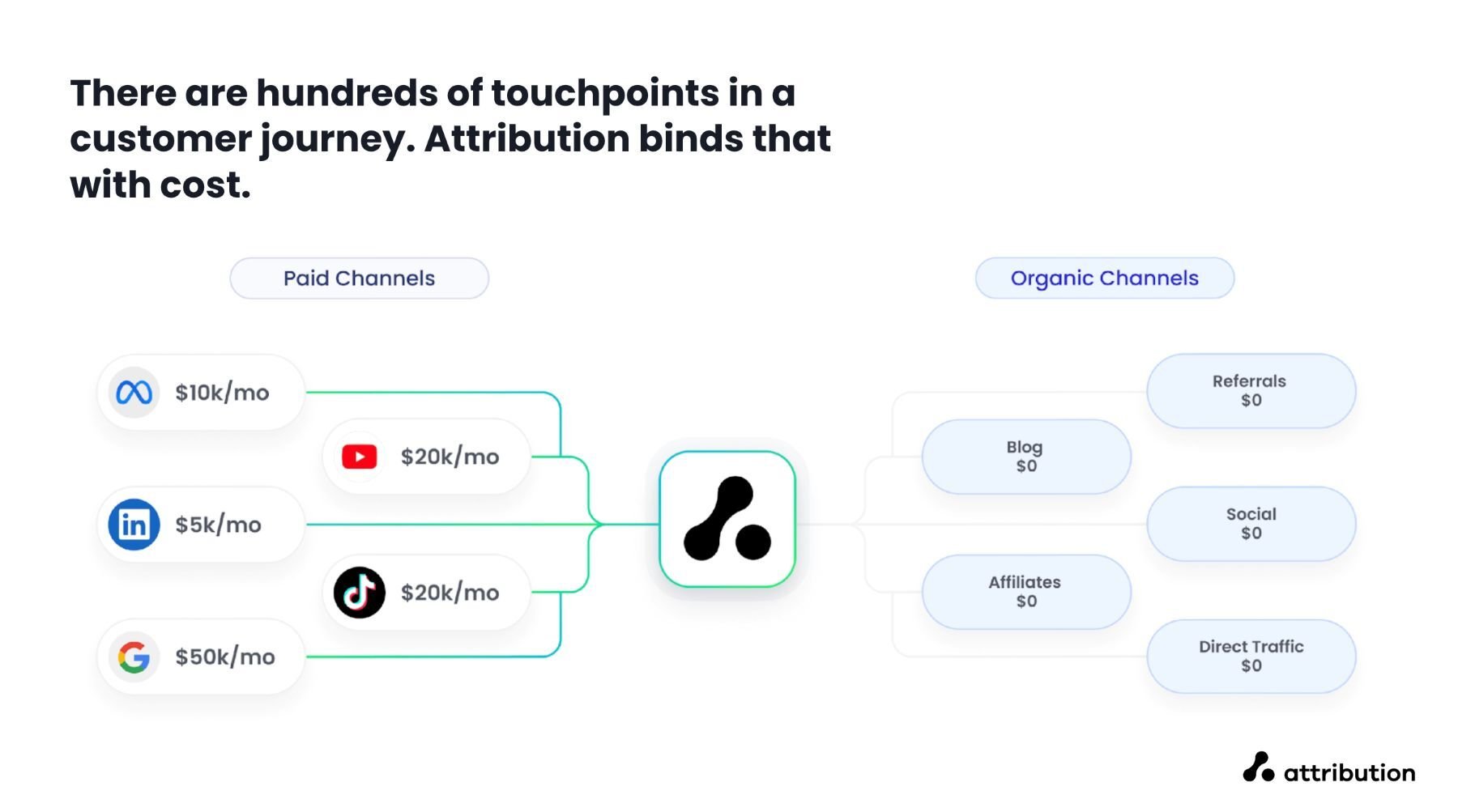
Attribution was built to unlock the full potential of HubSpot — turning it from a marketing and sales CRM into a financially auditable growth platform. Most HubSpot users can see what’s happening in their funnel — traffic, conversions, lifecycle stages — but not what’s working or why. Attribution solves that by binding every HubSpot touchpoint to real cost and revenue, so teams can finally measure return on every dollar spent across campaigns, ads, and content. The result is a single source of truth for GTM efficiency — directly inside the platform teams already live in.
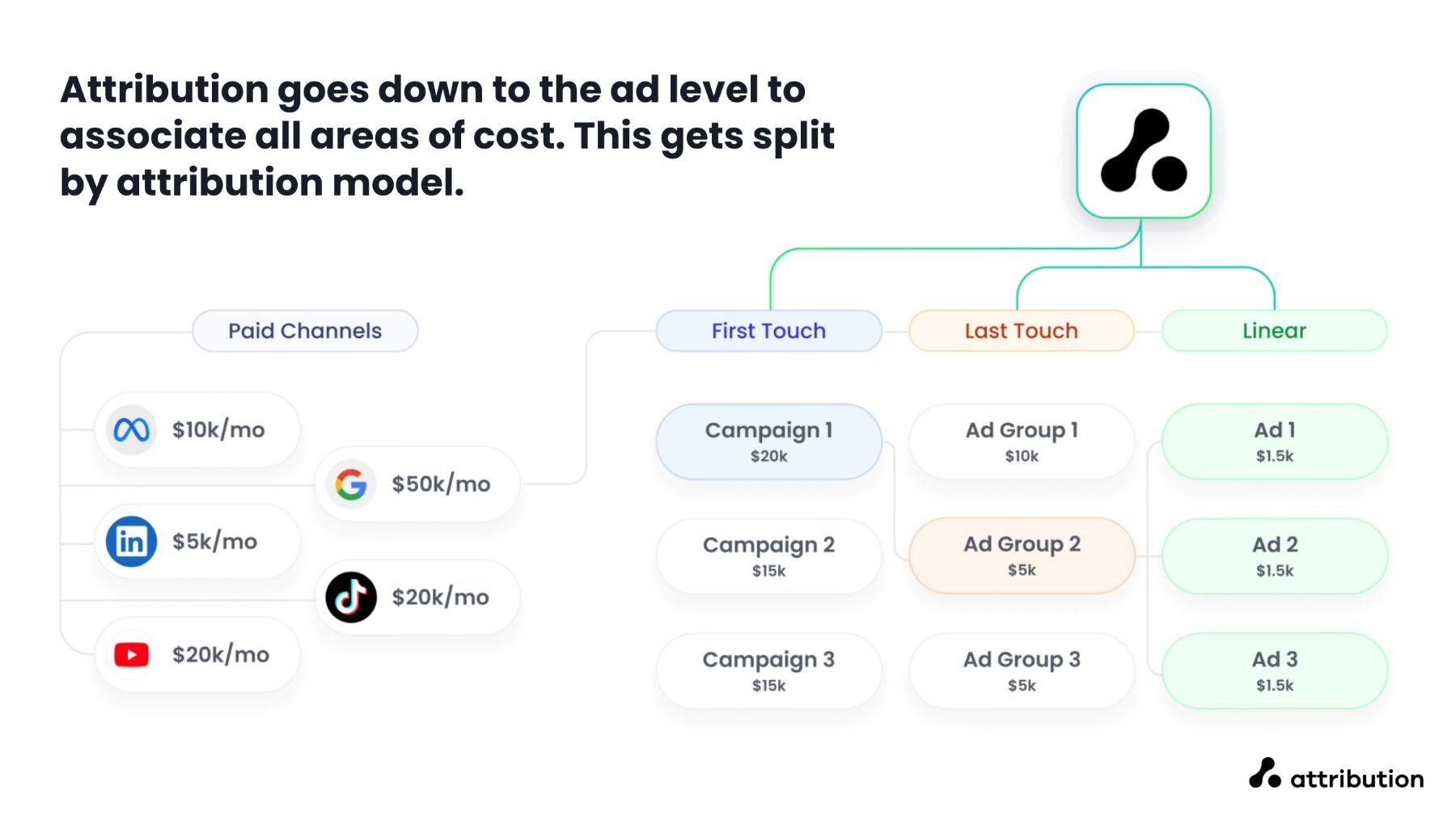
The first visual illustrates this connection clearly: HubSpot customers often have dozens of paid and organic channels feeding into their funnel — including Meta, LinkedIn, Google, TikTok, blog, social media, affiliates, and referrals. Attribution pulls all those signals into one unified view and binds them to cost, giving marketers, RevOps, and CFOs the same financial lens on performance. It’s the first time HubSpot users can trace a customer journey end-to-end — from ad spend to closed-won revenue — with full visibility and without leaving their CRM.
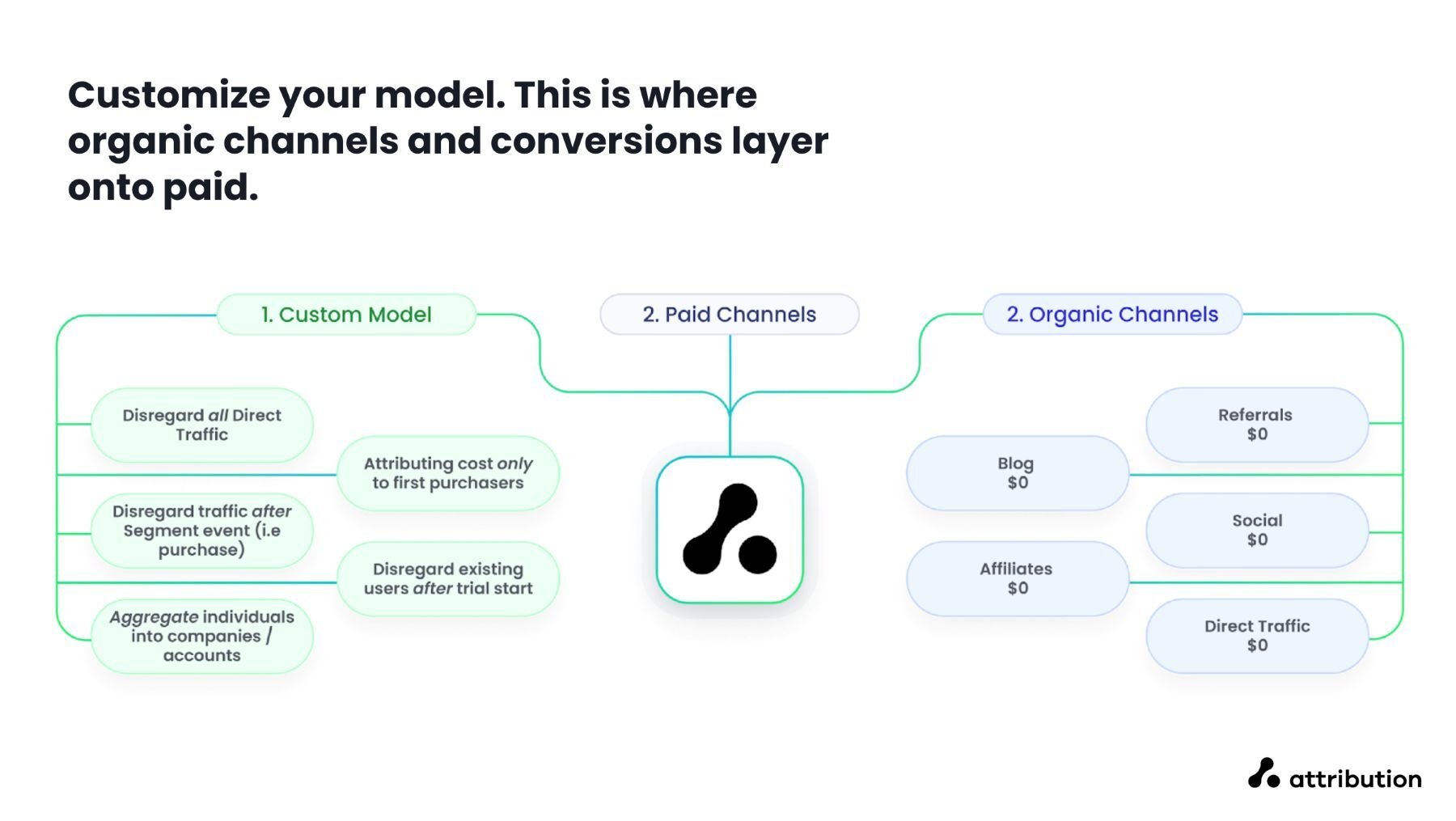
What makes Attribution unique alongside HubSpot is its ability to measure spend at the ad level and map it to different attribution models — first-touch, last-touch, linear, time-decay, or custom. The model visualization shows how Attribution dynamically splits and weights credit across campaigns, empowering teams to see not only where leads come from, but which touches actually drive revenue. For companies running multi-channel or multi-region GTM motions inside HubSpot, this means precise CAC Payback and LTV:CAC measurement without needing a separate BI stack.
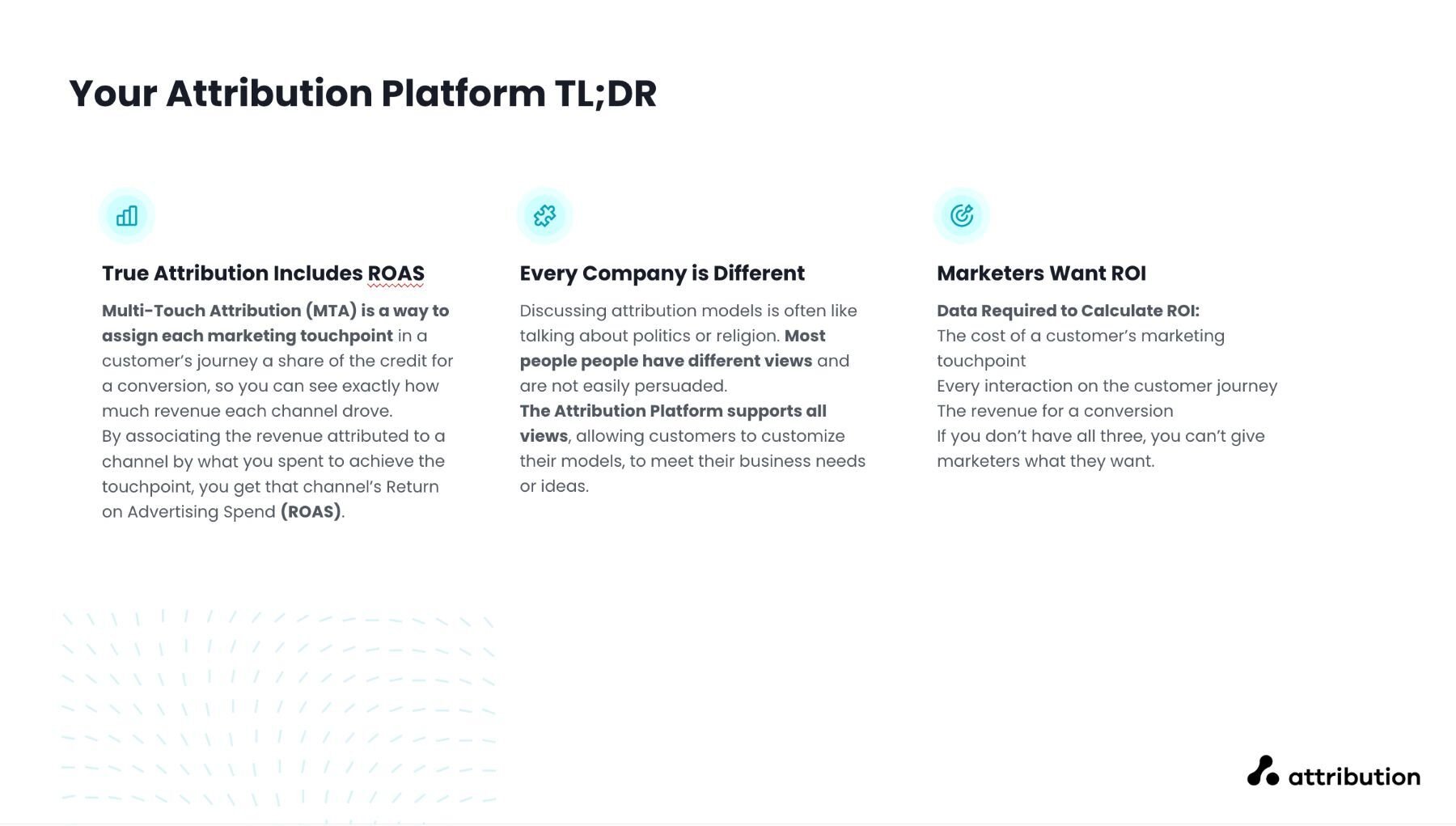
As shown in the custom model framework, Attribution lets HubSpot users build attribution models that match how their businesses operate — excluding direct traffic, filtering post-trial behavior, or grouping contacts into accounts. That flexibility makes HubSpot’s CRM data exponentially more valuable: marketers get clarity on which channels to scale, RevOps gets the data to improve efficiency, and finance gets confidence that CAC, ROAS, and payback periods are real — not modeled assumptions.
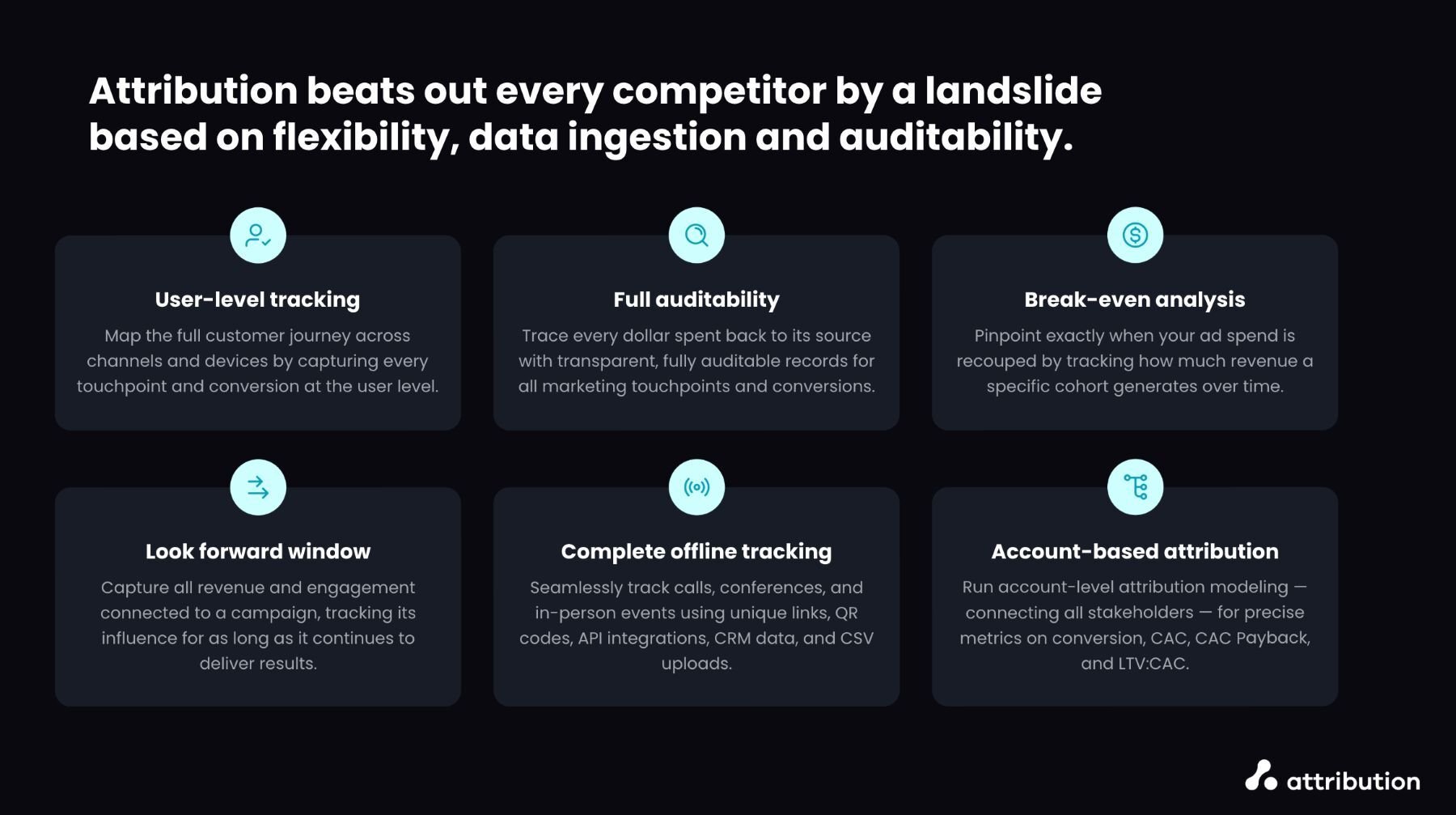
Finally, the capabilities overview demonstrates how deeply Attribution integrates with HubSpot’s core data objects. Every campaign, form submission, deal stage, and contact activity can be traced back to cost and revenue outcomes — enabling user-level tracking, break-even analysis, and account-based ROI reporting natively within HubSpot. For the first time, growth, marketing, and finance teams can operate from the same truth — with attribution that’s not just accurate, but auditable. Attribution doesn’t replace HubSpot. It perfects it — turning it into the ROI engine for modern GTM teams.
Attribution transforms HubSpot from a CRM of record into a system of financial truth — binding every campaign, ad, and deal to real cost and revenue. It gives marketers, RevOps, and finance teams one shared view of ROI, making HubSpot not just where growth is tracked, but where it’s proven.
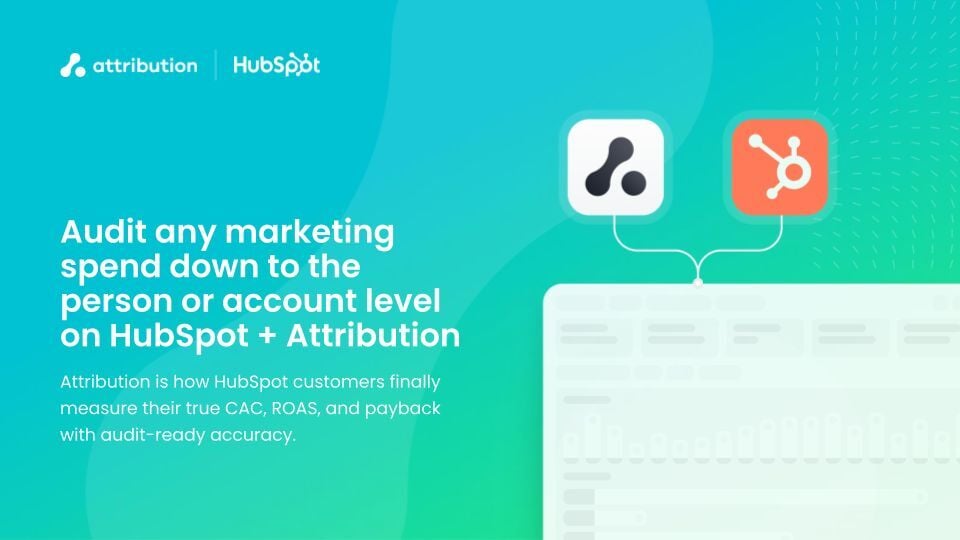
Attribution’s HubSpot integration was designed to bring audit-ready accuracy directly into the HubSpot ecosystem — unifying every marketing, sales, and finance signal around true ROI. As outlined in the HubSpot App Partner overview (slide 1), the integration allows HubSpot users to audit any marketing spend down to the person or account level. Whether you’re analyzing campaign CAC, channel ROAS, or payback, Attribution ensures that what’s shown inside HubSpot matches the real-world ledger.
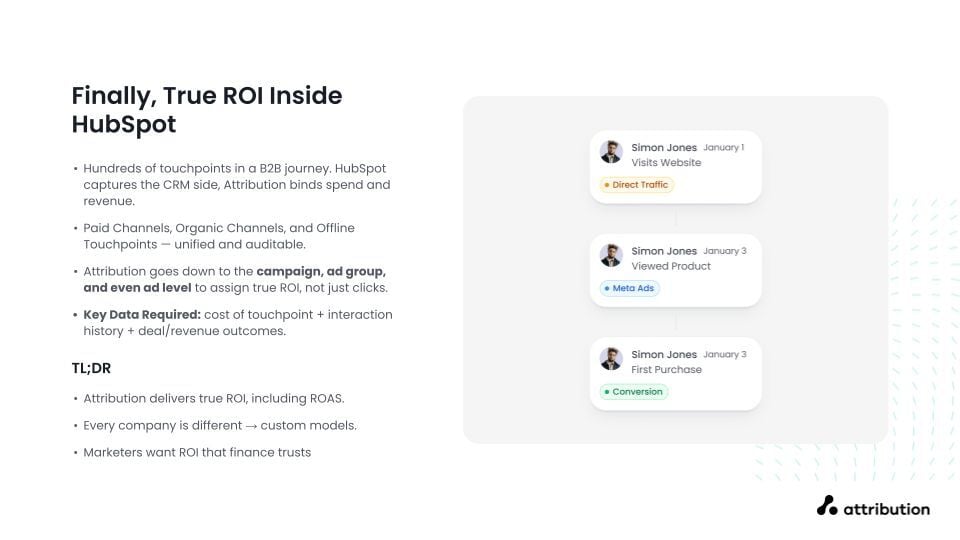
Alongside HubSpot, Attribution builds what the deck calls “True ROI with HubSpot”. It captures hundreds of touchpoints across ads, site visits, and offline engagements — then binds each to cost and revenue outcomes. The integration connects HubSpot’s CRM data with Attribution’s ad connectors, enabling users to measure spend not only by campaign, but by ad group and creative. This level of precision gives HubSpot teams visibility that’s impossible with native attribution models, which often stop at the first or last click.
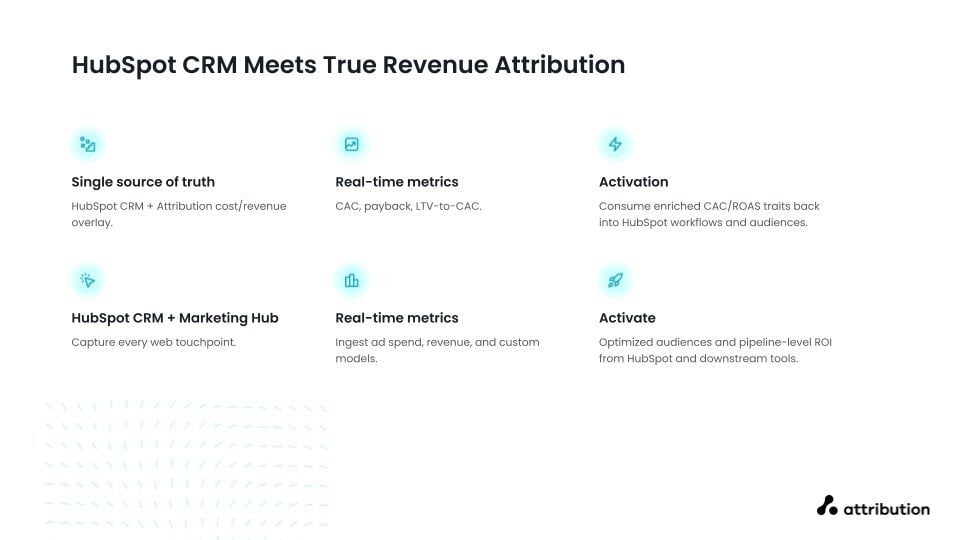
The integration works by creating a real-time cost and revenue overlay across HubSpot CRM and Marketing Hub. This means every deal and contact record becomes financially aware — showing CAC, payback, and LTV:CAC as native data points. Teams can even feed enriched traits like “ROI by campaign” or “high-payback audience” back into HubSpot workflows and segments, activating high-performing audiences across LinkedIn, Google Ads, and email.
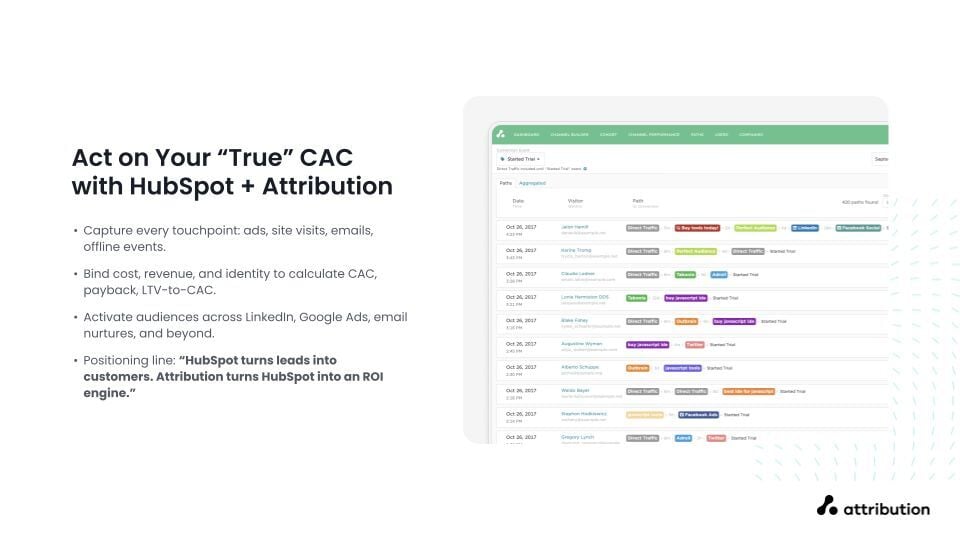
A major differentiator of Attribution’s HubSpot app is how it operationalizes “Act on your true CAC.” By binding cost, revenue, and identity data, HubSpot users can run full-funnel CAC analysis directly within their dashboards. The integration’s philosophy is summed up perfectly in the slide’s positioning line: “HubSpot turns leads into customers. Attribution turns HubSpot into an ROI engine.”
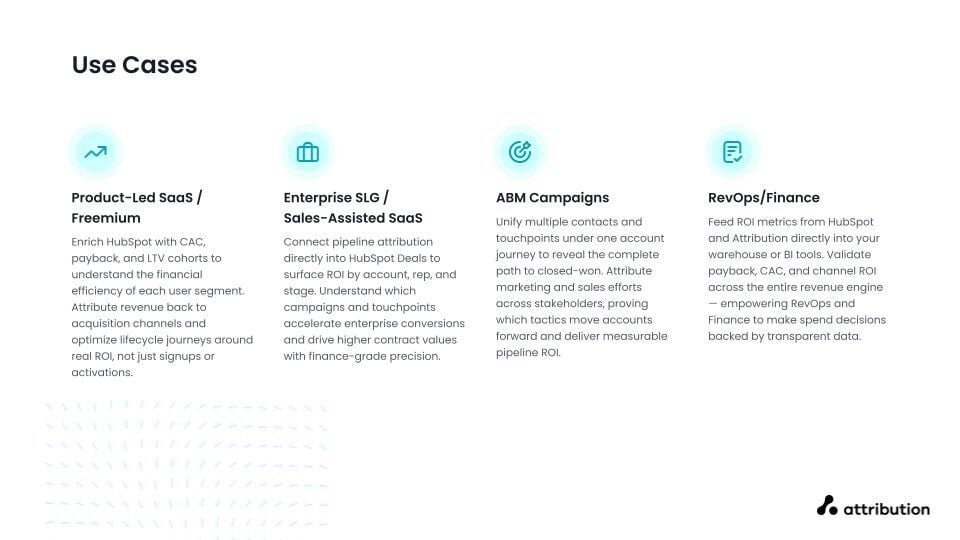
Beyond marketing analytics, the integration powers use cases across the entire GTM stack.
This flexibility turns HubSpot into a true growth operations command center — not just a CRM of record.

Attribution also gives HubSpot customers the “secret sauce” that most CRMs lack: full transparency and data export. Through its Data Export feature, every user can export auditable, user-level logs to Snowflake, BigQuery, or any warehouse — ensuring finance can validate CAC and payback directly from HubSpot data. For CFOs and RevOps leaders, this means complete confidence in what’s being reported in board decks and forecasts.
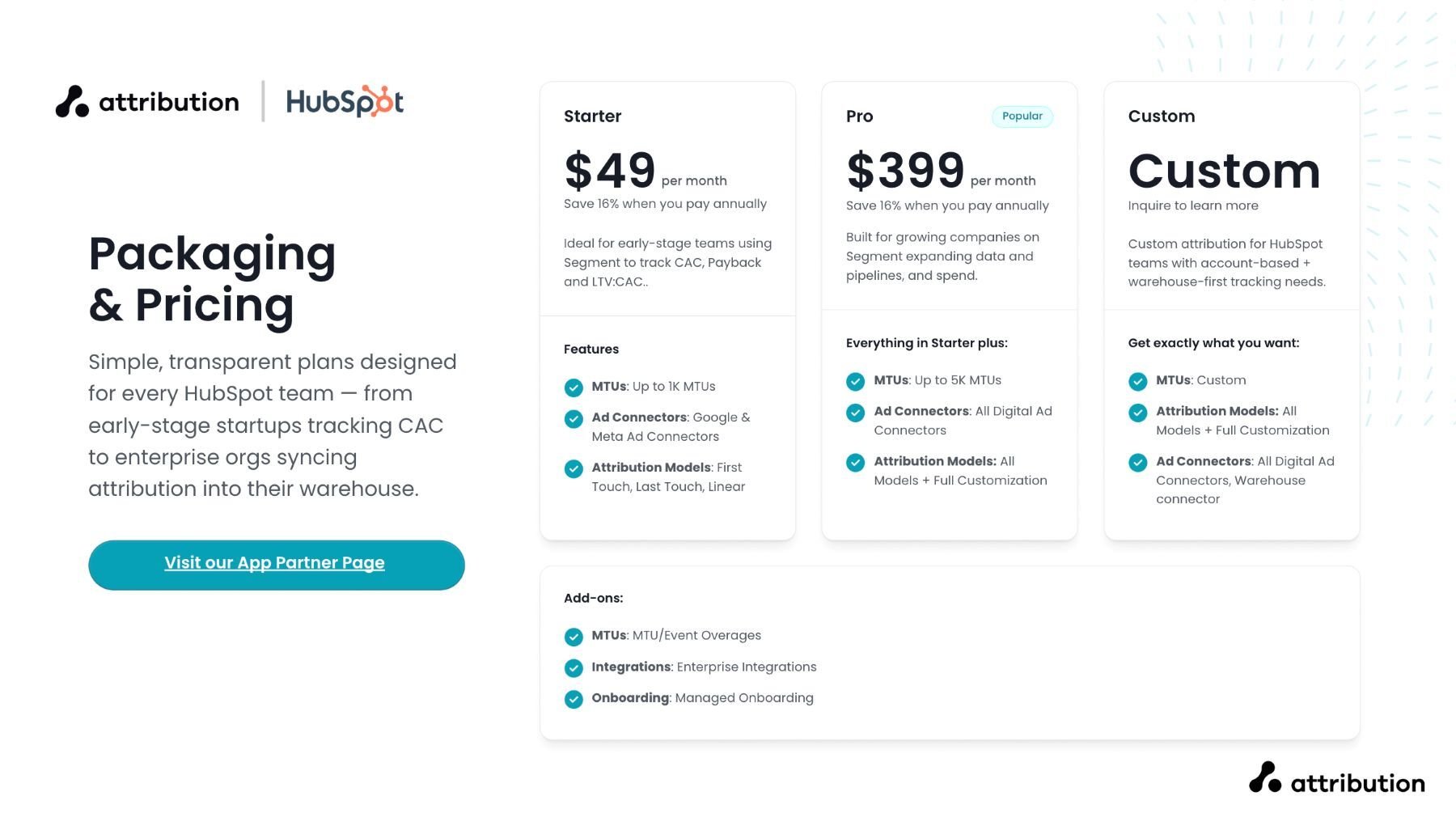
Finally, the Packaging & Pricing slide outlines transparent, scalable plans for every HubSpot user segment:
Each plan scales seamlessly with HubSpot’s ecosystem, ensuring that as your CRM grows, your attribution accuracy grows with it.
Attribution’s native HubSpot integration delivers end-to-end financial clarity — syncing spend, revenue, and identity data across every campaign, ad, and deal. With audit-ready metrics, real-time ROI overlays, and flexible pricing tiers, it turns HubSpot into a complete ROI engine where marketing, sales, and finance finally operate from the same truth.
Attribution is trusted by 1000+ growth teams to uncover what’s really driving revenue. From M-Files and Northspyre to Maropost, Newforma, Premier Generators, Dune Security, Leadpages, and many of the most efficient HubSpot organizations rely on Attribution to turn their CRM data into an auditable growth engine.
The HubSpot integration brings that level of truth to every team — connecting marketing spend, CRM data, and revenue outcomes in one view that’s both transparent and actionable. With Attribution, you can measure CAC, ROAS, and payback with investor-grade accuracy with HubSpot as the source. Every touchpoint, ad, and deal becomes fully attributable — so you can operate with confidence, not assumptions.
If your GTM motion runs on HubSpot, Attribution helps you see the full picture. Thousands of B2B teams already use it to optimize spend, accelerate payback, and bridge the gap between marketing and finance. Now, you can too.
Thank you for reading — and for building the kind of growth that’s not just faster, but smarter.


The Clay integration with HubSpot creates an AI stack that keeps data clean, automates enrichment, and helps startups scale faster with fewer tools.

The benefits of integrating AI into your startup's workplace; how it can streamline operations, boost productivity, and accelerate growth.

Learn how to turn every product sign-up into a hyper-personalized outreach opportunity using Clay and Twain's automated research and AI writing.
